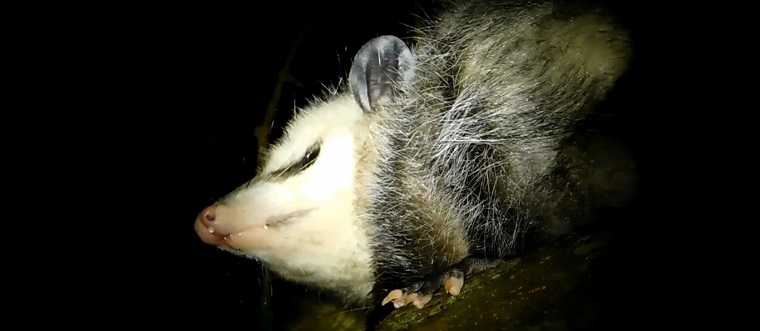Opossums could be easily mistaken to be rat relatives, due to similarities in appearance. However, these are marsupials that are actually thought to have shared the same land with a dinosaur species that has been extinct for over 70 million years.
The opossum is a close relative to other pouched animals or marsupials like the kangaroo and koala. The opossum bears the distinction of being North Americas only marsupial.
 Appearance
Appearance
Opossums are the size of a small dog measuring to about 76 cm from nose to tail and weigh between 8.8-13.2 lbs. They have long snouts and a narrow braincase with a jaw that has 50 teeth- more than any common mammal. They have prehensile tails which they can use to grab trees and even carry nesting materials.
The animals are sexually dimorphic with males appearing larger, heavier, and with bigger canines than the females. The most notable feature is the forked penis on the males. This characteristic was once a controversial and funny issue where some people believed that they bred with the female’s nose. Funny enough, they also thought that once the babies are born the mother sneeze them into the pouch.
The funny belief was not founded on any science and it was proved to be false and misguided since all marsupials have a similar life cycle.
Lifecycle
Female opossum gives birth to tiny helpless babies which then crawl into the mother's pouch for further development. The tiny babies are the size of a jelly bean and are referred to as joeys. Normally, they will start going in and out of the pouch as they grow. As they grow larger they will ride on the mother's back as she looks for food.
Opossums will give birth to as many as 20 babies but half of these barely survive and some won’t make it to the pouch. The gestation period is similar to other marsupials which are between 12-14 days. These babies are nursed in the marsupial pocket for 70-125 day where they detach from the teat and go out of the pouch. The lifespan of opossums is about 2-4 years and it’s shorter than most mammals its size.
Habitat
The common opossum, as well as Virginia opossum, are found in North America, South America, and Canada. They are nocturnal and they will mostly be found on trees and they also love wet places like marshes, streams, and swamps. These animals are excellent tree climbers and will spend most of their time on trees thanks to their sharp claws that sink into the tree barks to offer them good grip. Their prehensile tails are very useful in tree climbing and they use it as an extra limb for grasping and for balance.
Behavior
Being nocturnal, opossums will sleep throughout the day and stay awake at night to hunt and scavenge for food. Opossums will rarely hibernate but they will slow down during the winter. In the burrows they live in, they will line it with dry leaves or shredded paper for warmth. In the summer, they will cover their bodies in spit to help in cooling.
These animals are popular for “playing possum”. When threatened by a predator, they can effectively feign death by suddenly falling on their sides with eyes closed or fixated to space. They open their mouth and push the tongue out to fool the predator. It is believed that this in more of an involuntary act rather than a conscious one. Mostly, this plan works and allows them to escape unharmed.
Adult opossums are mostly depicted as hanging from the tails. This is not true because the tail is not strong enough to support a mature animal. The young opossums may pull this stunt but only for a few moments.
Opossums have a very good immune system which makes them partially or completely immune to most venom like:
● Bee stings
● Rattlesnake venoms
● Cottonmouth venoms
● Most pit vipers
Diets
Opossums are omnivores that will eat almost anything. When they intrude homes, they will scavenge the trash bins and eat pet food as well as forage on garden plants. In the wild, they will eat bugs, mice, birds, and even hunt for snakes. They are also attracted to dead animals and it's common to spot then on carrion and road kills.
Conclusion
Opossums are about eight times less likely to carry rabies than wild dogs. Although they will hiss and growl at humans they are considered nonaggressive animals by the Humane Society. Apart from the interesting fact that they have more teeth than any other mammal in North America, opossums also have opposable thumbs on their hind limbs to aid firm grasping when climbing trees.
Go back to the
How to Kill Opossums page.